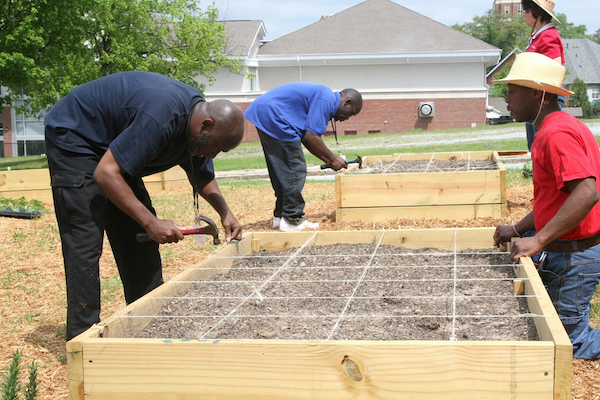Backyard gardeners with limited space may want to try gardening in raised beds.
“Many gardeners choose raised-bed container gardens because they are easier to access and there’s less soil compaction,” said David Berle, a horticulturist with the University of Georgia College of Agricultural and Environmental Sciences.
Raised beds, or “giant flower pots” as he calls them, are ideal for gardeners who have a “tough, urban site” where the soil conditions are not ideal, Berle said.
“They are perfect for school gardens because they can go where there isn’t any soil. In theory you could put a box on top of asphalt. And, the kids can’t trample the plants,” Berle said.
Raised beds are ideal for gardeners with physical ailments, like back or knee issues, and wheelchair users who garden.
A raised bed built for accessibility by the disabled should be at least 36 inches away from another raised bed and should be raised to a height of at least 24 inches so a wheelchair can be rolled underneath the garden, Berle said.
When building a wheelchair-accessible raised garden, the surface must be firm and stable. Do not build on a slope. Berle recommends consulting a horticulture therapy organization for more detailed information.
When constructing any raised bed, Berle recommends not building the bed wider than arm’s reach from either side — 24-36 inches. “Three or 4 feet wide is a good overall width, depending on the gardener’s size,” he said.
Along with the advantages of a raised bed garden come several disadvantages. The soil dries out quicker, which causes the plants to require water more often. Raised bed gardens are also much harder to till.
“It’s hard to use a tiller (plow) in a box. You have to lift it up and put it in there and then it’s hard to operate. So it’s going to be a little bit harder to mix the soil in a raised-bed garden,” he said.
Soil has to be added to a raised-bed garden, and that costs money.
“A garden that’s 4 feet wide and 8 feet long will need 5 cubic yards of soil, which has to come from somewhere,” he said. “If you buy bulk topsoil, you’ll likely get soil that was scrapped away from a poor site. If you’re not careful, you could buy the same soil you didn’t want to plant in to begin with.”
Topsoil purchased in bags is usually a mix of bark compost and sand, not real topsoil at all, he said. Plain soil, amended with a little compost, is the best choice for raised beds. If local soil is not available, a mix of potting soil and compost is the best material with which to fill a raised bed.
The cost of building and filling a raised bed is a big disadvantage over just gardening in the ground. Raised-bed gardens can be ordered as prefabricated or preassembled kits or built from a wide variety of materials.
To save money, Berle recommends building with less costly materials.
“A raised bed can be made of pallets lined with landscape fabric. It won’t be as attractive as others, but it will work,” he said.
Raised beds can be built from metal objects, like old cattle troughs. “Just drill holes in the bottom and you are done,” he said. “Or a garden can be made from baby pools and plastic barrels cut in half,” he said.
Cement blocks can be used, but they are not cheap. The average cost is $1.50 to $2 each. “And, if the ground’s not level, you are going to spend a lot of time scrapping the earth,” Berle said.
Recycled concrete pieces can be used to build a wall around a raised bed, just remember that concrete contains calcium and will likely affect the soil’s pH.
Avoid rubber tires. “I would be concerned about chemicals in the tire getting into the soil,” Berle said.
Before building a wooden raised bed, read these tips from Berle and UGA Extension:
- Use at least 2-inch-thick lumber. One-inch-thick lumber isn’t sturdy enough.
- Keep in mind that lumber is sold in 8-, 10-, and 12-foot lengths. Plan the garden size so as not to waste lumber.
- Southern untreated pine is inexpensive, but it will only last a few years. And railroad ties and telephone poles are known to release creosote into the soil.
“Gardeners following USDA Organic growing guidelines cannot use common treated wood to build a raised bed. Telephone poles and railroad ties are also off the list for organic standards,” he said. “Remember, whatever is in the wood can leach into your soil.”
For more on raised-bed gardening, search the subject on the UGA Extension publications website at extension.uga.edu/publications/.








